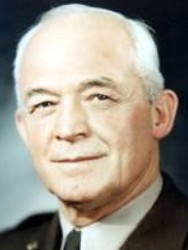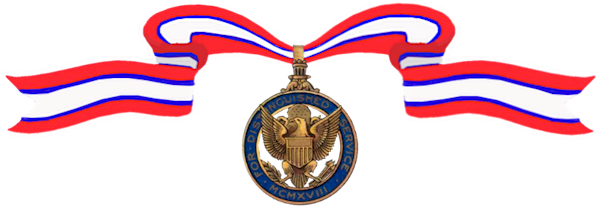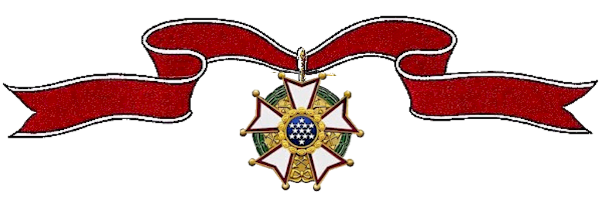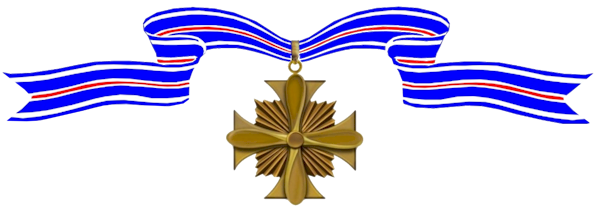Henry Arnold graduated from the U.S. Military Academy at West Point, Class of 1907. During World War II he was appointed a 4-Star General in the Army Air Forces, fourth in Army seniority behind Generals Marshall, MacArthur, and Eisenhower, retiring at that rank in 1946. In 1949, under Public Law 282-78, he was promoted to 5-Star rank in the U.S. Air Force, becoming the first, and only, five-star General of the Air Force.

–
Cemetery:
Awards Received
-

Army Distinguished Service Medal
-

Legion of Merit
-

Army Distinguished Service Medal
-

Army Distinguished Service Medal
-
Army Distinguished Service Medal
Service:
United States Army Air ForcesRank:
General of the ArmyAction Date:
March 1942 – April 1944
War Department, General Orders No. 18 (February 13, 1946), Correction under G.O. 61 (June 27, 1946)The President of the United States of America, authorized by Act of Congress July 9, 1918, takes pleasure in presenting a Second Bronze Oak Leaf Cluster in lieu of a Third Award of the Army Distinguished Service Medal to General of the Army Henry Harley “Hap” Arnold (ASN: 0-2255), United States Army Air Forces, for exceptionally meritorious and distinguished services to the Government of the United States, in a duty of great responsibility as Commanding General of the Army Air Forces during the period from March 1942 to April 1944. General Arnold directed air activities for the nation’s global war against Germany and Japan. Under him the air arm grew from 22,000 officers and men with 3,900 planes to nearly 2,500,000 men and 75,000 aircraft. Early in 1943 General Arnold made a 35,000-mile tour of North Africa, Middle East, India and China, and attended the Casablanca Conferences. The singularly distinctive accomplishments of General Arnold reflect the highest credit upon himself and the United States Army Air Forces.
-
Legion of Merit
Service:
United States Army Air ForcesRank:
General of the ArmyAction Date:
World War II
(Citation Needed) – SYNOPSIS: General of the Army Henry Harley “Hap” Arnold (ASN: 0-2255), United States Army Air Forces, was awarded the Legion of Merit for exceptionally meritorious conduct in the performance of outstanding services to the Government of the United States during World War II. The singularly distinctive accomplishments of General Arnold and his dedicated contributions reflect the highest credit upon himself and the United States Army Air Forces.
-
Army Distinguished Service Medal
Service:
United States Army Air CorpsRank:
Lieutenant GeneralDivision:
Army Air ForcesAction Date:
September 29, 1938 – March 8, 1942
War Department, General Orders No. 51 (October 2, 1942)The President of the United States of America, authorized by Act of Congress July 9, 1918, takes pleasure in presenting the Army Distinguished Service Medal to Lieutenant General Henry Harley “Hap” Arnold (ASN: 0-2255), United States Army Air Forces, for exceptionally meritorious and distinguished service in the performance of duties of great responsibility as Chief of the Air Corps from 29 September 1938 to 31 May 1941, as Deputy Chief of Staff for Air from 29 November 1940 to 8 March 1942, and as Chief of the Army Air Forces from 20 June 1941 to 8 March 1942. He performed the duties required by the office in a superior manner during the most strenuous and trying period in the history of the air arm. During this period, an Air Corps Program of Expansion and Procurement was inaugurated whereby the personnel of the Air Forces was increased in excess of a thousand per cent and the number of aircraft increased proportionately. A program of expansion and procurement of this magnitude demanded comprehensive planning, its execution required outstanding ability, foresight, and leadership, all of which were exhibited by Lieutenant General Arnold in a high degree. He impressed this high quality of leadership, so vitally needed during this period.
-
Army Distinguished Service Medal
Service:
United States Army Air ForcesRank:
General of the ArmyDivision:
Army Air ForcesAction Date:
World War II
War Department, General Orders No. 92 (October 25, 1945)The President of the United States of America, authorized by Act of Congress July 9, 1918, takes pleasure in presenting a Bronze Oak Leaf Cluster in lieu of a Second Award of the Army Distinguished Service Medal to General of the Army Henry Harley “Hap” Arnold (ASN: 0-2255), United States Army Air Forces, for exceptionally meritorious and distinguished service in the performance of duties of great responsibility as Commander of the Army Air Forces during World War II. To him fell the mission of building American air power for a global war in which victory or defeat depended on control of the skies. He fulfilled his mission in a manner that overwhelmed this nation’s enemies and awed its allies. He welded the civilian productive genius of the aircraft industry, an expert military nucleus and more than 2,000,000 American soldiers to form an indomitable, unprecedented destructive weapon which coordinated with our land and sea forces to obliterate the Axis powers. As a member of the Joint Chiefs of Staff and the United States and British Combined Chiefs of Staff, General Arnold helped shape the strategy and direct the resources of the victorious Allied forces. His wide knowledge of the employment of air power was of great value to the deliberations of the Chiefs of Staff. From concept to execution, General Arnold’s leadership guided the mightiest air force in history. No single factor of the great allied victories was more vital than the destruction of the capacity of Germany and Japan to wage modern technological warfare. The long range precision attacks of massed air power which accomplished this objective were the products of his genius. At the same time General Arnold directed the training and equipment of the United States Tactical Air Force so that when the great decisive three-dimensional battles of World War II were joined, his fighters and attack bombers were ready to sweep the skies of the enemy and deny him mobility on the surface. During the growth of the Air Arm, General Arnold constantly increased the effectiveness of its activities by imaginative conceptions concerning the application of air power to strategy and tactics and by the development of potent new weapons. The singularly distinctive accomplishments of General Arnold and his dedicated contributions in the service of his country reflect the highest credit upon himself and the United States Army Air Forces.


